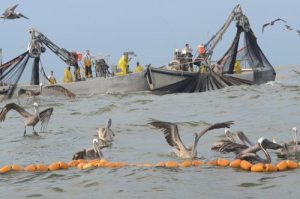‘America’s Third Coast’ book series broadens the audience for coastal research

The state’s fisheries – such as the menhaden industry (pictured) – was and is influential in shaping the fabric of Louisiana coastal communities. The America’s Third Coast book series explores the Northern Gulf of Mexico’s history, life, industries and culture through book-length manuscripts designed for the general public to policy makers.
Louisiana Sea Grant (LSG) Scholars Carl Brasseaux and Don Davis seek to fulfill an unmet need with their upcoming America’s Third Coast Series. They are pushing research outside the realm of peer-reviewed academic journals and into a book-length format designed to be more accessible to policy makers, coastal residents and the general public. The duo is preparing to publish up to three titles a year that focus on the Gulf Coast – addressing the region’s history, life, industry and culture. Brasseaux and Davis are editing the series and coauthored one volume.
“Traditionally, one can find numerous books dealing with coastal issues on the Atlantic and the Pacific, but in some ways the northern Gulf of Mexico, considered the Third Coast, has been ignored,” Davis said when describing the origins of the project title. “This series is designed to try to encourage all scientists, but with some interest toward the social sciences, to consider book-length manuscripts directed at a new audience that is broader than academia. We are getting outside our comfort zone a tad.”
Brasseaux and Davis lead off the series with their work Ain’t There No More: Louisiana’s Disappearing Coastal Plain, tracing the economically driven environmental changes that reshaped the state’s coastal parishes from the beginnings of colonization to the region’s post-embargo oil boom. Their account of coastal erosion, long-term neglect and manmade disasters features nearly 300 illustrations, many of which are rare and previously unpublished. Their volume is expected to be followed by Shane Bernard’s book on nutria, LSG retiree Jessica Schexnayder’s project documenting endangered coastal cemeteries, and LSG Assistant Associate Director of Research Matt Bethel’s work on traditional ecological knowledge.
Costly hurricanes over the last decade and the 2010 Deepwater Horizon oil spill have raised international awareness of the challenges Louisiana faces, but Brasseaux and Davis hope to move the Gulf of Mexico region into the forefront of the nation’s consciousness and to lead readers into a discussion on restoring and rehabilitating the coast in cooperation with the coastal population.
“Where does the Gulf Coast factor into the American narrative?” Brasseaux asked. “When someone makes reference to the East Coast and West Coast, the words ‘Gulf Coast’ never seem to follow. Few would include the southern coast’s modern metropolis, Houston—now the fourth largest city in the United States—in the same breath as New York, Los Angeles and Chicago. Only when disaster strikes do Americans turn their attention to the Gulf South.”
“You have the landscape and the peoplescape,” Davis added. “The landscape only has meaning with the peoplescape. This series will highlight the economic activities and environmental stewardship of the inhabitants of this diverse region.”
America’s Third Coast Series will be published by the University Press of Mississippi with support from the Louisiana Sea Grant College Program and the Louisiana Sea Grant Foundation.
On the web:
University Press of Mississippi, www.upress.state.ms.us
